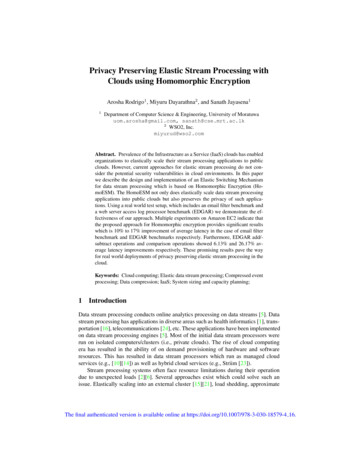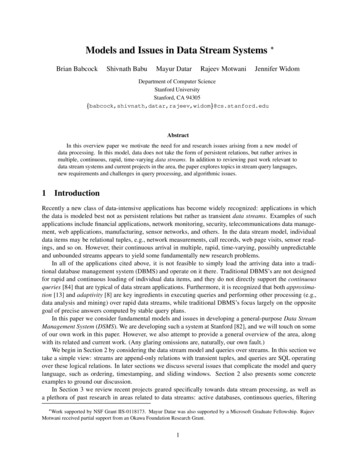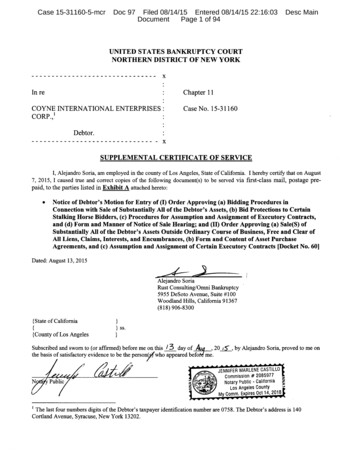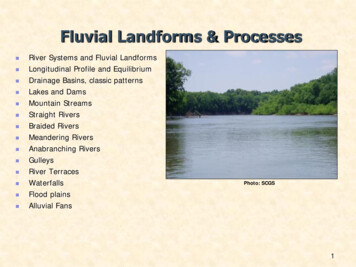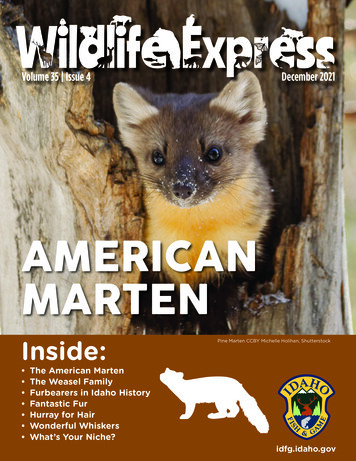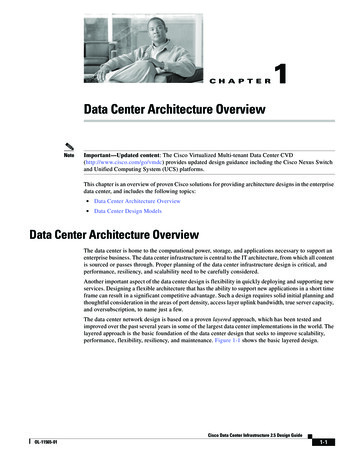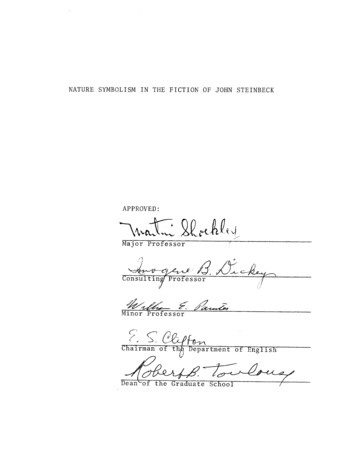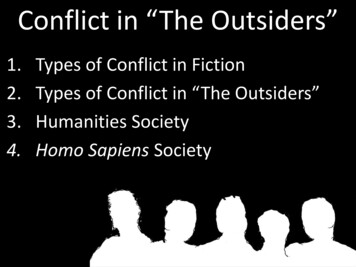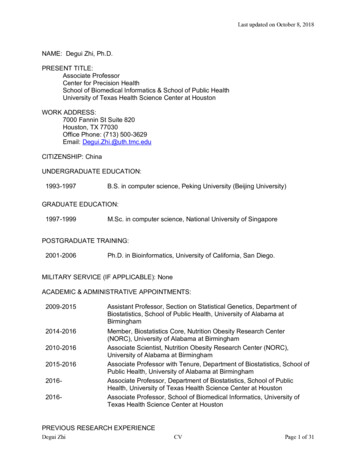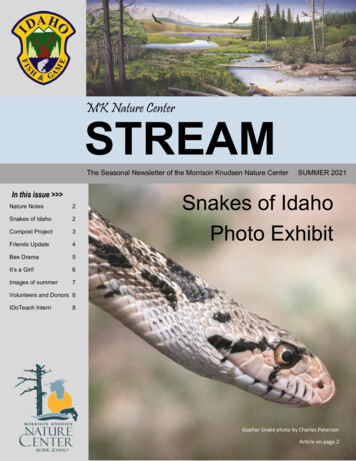
Transcription
MK Nature CenterSTREAMThe Seasonal Newsletter of the Morrison Knudsen Nature CenterNature Notes2Snakes of Idaho2Compost Project3Friends Update4Bee Drama5It’s a Girl!6Images of summer7SUMMER 2021Snakes of IdahoPhoto ExhibitVolunteers and Donors 8IDoTeach Intern8Gopher Snake photo by Charles Peterson1Article on page 2
Nature NotesVicky Runnoe, Conservation Education Supervisor, IDFGOne of the highlights of early summer is the arrival of mule deer fawns.Tottering on impossibly long legs and crowned with enormous ears, theyeasily capture the hearts of staff and visitors alike. While seeing thefawns is always a thrill, what is even more exciting is watching the reactions of nature center visitors if they catch a glimpse of a fawn. I remember a particular family standing in thrilled silence as a doe and her fawncrossed the path in front of the family. As it turned out, this was the firstMule deer fawn. Photo by Bronwyn Myers.mule deer fawn they had ever seen, and the looks on their faces said it all.Even experienced outdoorsmen pause, roughened features softening at the sight of a doe with her tiny fawn daintilymaking their way into the trees.Seeing mule deer may seem old hat to many of us, but for a lot of urban residents, it is anything but. For those of us forwhom wildlife is an important part of our connection to the land, we need to remember our own initial excitement atseeing a “lifer” critter. Here at the nature center, we hope to foster such moments for all visitors by providing healthyhabitat for our wild residents. Our education programs offer additional ways to see wildlife and forge connections.This summer, come down and stop by one of our education tables. The topics are varied, yet always fascinating andour volunteers are ready and willing to share their knowledge. You never know what tidbit of information might justspark a lifelong interest. And if you are lucky, one of the fawns just might appear, giving you the chance to simplypause and enjoy. We hope to see you soon.Snakes of IdahoAustin Reich, AmeriCorps Member, MKNCFor the Month of June the MK Nature Center had the privilege ofhosting the “Snakes of Idaho” photo exhibit by Dr. Charles“Chuck” Peterson. Starting it all off with a presentation on hisphotographs, Dr. Peterson shared decades worth of research,knowledge, anecdotes, and beautiful photos of the 12 species ofsnakes you can find in Idaho.Ring-necked snake photo by Charles PetersonSnakes of Idaho Exhibit at MKNC. Photo by IDFGChuck also shared of the importance of theiNaturalist projects for reptiles and amphibians,describing the impact of the citizen scienceproject for researchers in Idaho. If you happenacross the slimy, scaly, or slithery, put in yourobservations at the link below and helpscientists across the state understand thenatural history of these amazing hoamphibian-and-reptile-inaturalist-project22
Let’s Compost!Sara Focht, Wildlife Educator, MKNCThe Gray Beards* have done it again! They have constructeda new compost bin at the MK Nature Center. The old bin wasso effective that it was starting to compost itself and the wallswere deteriorating. To solve that dilemma this time, the wallswere constructed out of cinder blocks-totally noncompostable!The compost pile at the Nature Center plays an essential rolein creating habitat and recycling nutrients. Leaves, planttrimmings, and pond scum are all added to the pile for wormsand fungus to decompose. The result is nutrient-rich soil weuse to enhance native flower beds and gardens.Composting is an important natural process that can beaccelerated by placing organic matter in a pile! Not only dowe get the benefit of the end product, but we help keeporganic material out of the landfill. Come check out our newcompost pile next time you are here.Top: Gary Hundt fortifies the walls with concrete.Bottom: The finished product with the crew pictured left to right (Howard Sheppa, Kevin Drews,Steve Berg, Gary Hundt). Not pictured Brent Davy and Kevin Wilson. Photos courtesy, The GrayBeards.*The Gray Beards are a selfnamed dedicated volunteergroup made up of Idaho MasterNaturalists. They take onprojects big and small at theNature Center. The GrayBeards accept new members. Agray beard is not required tojoin!33
Friends UpdateKim Chmura, FoMKNC Board MemberThe long awaited new MKNC information kiosk is wellunder construction. The Friends of MKNC thanks ourmany members and donors for making this ambitiousproject a reality. In addition, Boise Cascade donated muchof the lumber needed for this project, and with today’swood prices, this gift was a true budget-saver. To all whocontributed to this project, we are extremely grateful!!The new kiosk will replace a structure that was built in theearly 1990’s, original to the nature center. The oldstructure served its purpose as an educational display andstorage shed for many years, but ants, squirrels, weather,and good old-fashioned rot took its toll, and a replacementwas sorely needed.The new kiosk was designed to create a state-of-the-arteducational window with a large display space andlighting, while providing much needed storage space foreducational materials and maintenance equipment. Thestructure has a cantilevered roof over the outdoor space toprovide a shaded and dry area for our volunteers staffing“learning tables”, and our visitors to rest and enjoy thenature center surroundings. The new kiosk is also in aperfect location, right at the intersection of severalpathways!The educational displays in the kiosk are designed to teachvisitors about key concepts in nature that are seasonallyrelevant, such as migrating and spawning salmon, turkeyadaptations, winter survival strategies and pollination. Wehope these displays delight and inspire our visitors, whilecreating a greater awareness and understanding of Idaho’snatural environment.We hope that you will visit the MKNC soon to see howyour donations are making a difference in the educationalopportunities and overall visitor experience. Again, a huge“Thank You!!” to our many donors to the Friends ofMKNC for making projects like this new kiosk possible!!4Friends of MK Nature Centerraised 19, 050 in May during the 2021 Idaho GivesCampaign. This money willlaunch their next big projectwhich will be to replace theAuditorium bird-viewing areawith bird-friendly glass and anew educational mural.
As the Hive BuzzedVicky Runnoe, Conservation Education SupervisorAs it turns out, an observation hive is rather like a soap opera. A varying cast of characters, mysteriousdisappearances, regicide, abandonment, and changing loyalties make for never a dull moment. But theopportunities for learning are endless and the rewards are sweet, indeed.The bees overwintered very well and we were looking forward to an active hive this season. However, a muchneeded HVAC replacement intervened. Naturally, where the work needed to be done was directly underneath thehive. We decided that the good folks from YMC, Inc. would probably appreciate a work environment free ofarmed, flying insects, so the display was dismantled, including the hive. The bees went to beekeeper RogerWallace for the duration.Fast forward several weeks and we had a wonderful new, fully-functional HVAC unit. It was time to bring backthe bees. Upon their return, however, it was discovered that the hive was queen-less. What happened to her in theinterim is anyone’s guess, but the bees had taken things in hand and created several queen cells. For a week, wekept an eye out and finally, a new queen emerged. After a week or so of wandering around the hive with no egglaying activity, she disappeared. She might have gotten lost on her mating flight, was killed by the workers, orabandoned the hive altogether. Once again we were left with a queen-less hive, but this time there were no larvaeavailable for the workers to raise queen cells. Into the breach stepped Roger to bring us another colony. Theaccompanying photos show Team Apis installing the new colony into the observation hive.This new hive of bees settled right in and has been, well, busy as bees. They have been so busy, in fact, that theyfilled their honey frame, allowing us to harvest just shy of three pints of honey at the end of June. The colony isquite content, indicating a healthy, productive queen. Nature center visitors are enjoying observing the bees againand learning about the importance of all pollinators. If you come by to see the bees, the new queen has a white doton her thorax, making her easy to find amongst the rest of the colony.Vicky Runnoe (IDFG), along with bee volunteers Roger Wallace,Kevin Drews, Kevin Wilson, and Howard Sheppa. Photo by IDFG.June 115Septeber 12 smoke
It’s a Girl!For the first time since she arrived at the nature centerWilson, the center’s non-releasable peregrine falcon, laidsome eggs. In fact, since she had not done so for so long,we often wondered if “she” was actually a “he?” But egg-laying confirms her gender.So, why did it take her so long to lay eggs? At betweensix and seven years old, it seems reasonable that Wilsonshould have laid eggs previously. In order to get someclues to her behavior, it helps to look at the breedingbehavior of wild peregrines. In the wild, femaleperegrines often lay their first clutch when they are twothree years old. Wild birds that do not have a breedingterritory often postpone egg-laying until later. SinceWilson does notWilson, the Peregrine Falcon. Photos by Brian Lawless.have such a territory, this could beone factor in the postponement of her egg-laying.Another factor could be the lack of a male to initiate courtship. While photoperiodis involved in the breeding cycle, so are active courtship behaviors. How suchbehaviors impact the hormonal changes that occur during the breeding season isnot well understood, but biologists feel they are indeed linked.In addition, male peregrines feed their mate---a lot! Extra nutrition above andbeyond a normal diet is necessary for egg-laying. Wild females benefit from theextra meals brought to them by their mates. Even with Wilson’s nutritionallycomplete diet in captivity, it may not have been enough for her body to initiate egg-laying.Egg photo by Maria Donovan.We will probably never know exactly why Wilson has not laid eggs until now.Raptor behavior in captivity can be quite different from that of a wild bird.Captivity, even with the best of care can still create stresses on the bird that areunseen by handlers. It will be interesting to see if this is a one-off or if Wilsonbecomes more regular in her egg-laying in the future.6
Images of SummerNative bee on chicory, mule deer doe and fawn photos by Vicky Runnoe (IDFG). Swallowtail butterfly in hand by Sara Focht (IDFG).7
VOLUNTEERSKim BaarSteve BergKody CochrellKevin DrewsJon DudleyElizabeth GrosseGary HundtCarolyn KingKevin LaughlinCindy MarlowJon MathewsBronwyn MyersLyla OlsonKatherine PowellHoward SheppaChuck StaberClaire VesethRoger WallaceKevin WilsonDONORSJohn and Edwina AllenAprilMayJuneSue and Jim JamesonWild Birds UnlimitedDonors listed here do not includedonors who gave to Friends of MKNature Center (the Nature Center’s501c3 nonprofit organization).IDoTeach Summer InternMy name is Abby Goodell and I am the Boise StateIDoTeach intern here at MK Nature Center for the summer.I am originally from the Seattle, Washington area but havecome to love Idaho and the community at Boise State,especially from the teaching program. I am a mathematicsmajor with an emphasis in secondary education, soteaching about wildlife has been a bit different than what Iam used to. However, it is so fun to see the kids in theprograms get so excited about nature and wildlife.Photo by IDFG.My favorite way to spend my time is being outdoors,whether that is camping, hiking, or just exploring all thatIdaho has to offer. Being at the nature center I have learnedeven more about wildlife and that has gotten me excited toget younger kids interested and excited about the outdoorsand exploring nature.Idaho Department of Fish and Game (IDFG) adheres to all applicable state and federal laws and regulations related to discrimination on the basis of race, color, national origin,age, gender, disability or veteran’s status. If you feel you have been discriminated against in any program, activity, or facility of Idaho Fish and Game, or if you desire furtherinformation, please write to: Idaho Department of Fish and Game, P.O. Box 25, Boise, ID 83707 OR U.S. Fish and Wildlife Service, Division of Federal Assistance, Mailstop:MBSP-4020, 4401 N. Fairfax Drive, Arlington, VA 22203, Telephone: (703) 358-2156. This publication will be made available in alternative formats upon request. Pleasecontact the Department of Fish and Game for assistance. Costs associated with this publication are available from IDFG in accordance with section 60-202, Idaho Code. MKNCStream Newsletter58914,7-1-2021 125/Sara Focht.8
lighting, while providing much needed storage space for educational materials and maintenance equipment. The structure has a cantilevered roof over the outdoor space to provide a shaded and dry area for our volunteers staffing “learning tables”, and our visitors to rest and enjoy the . Kim
